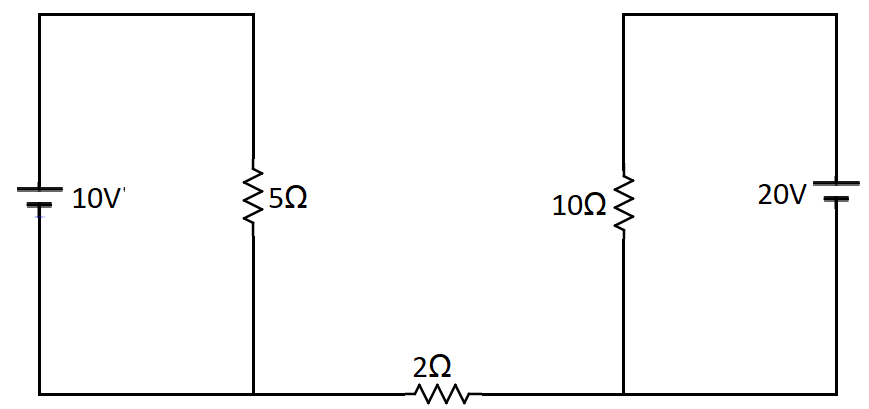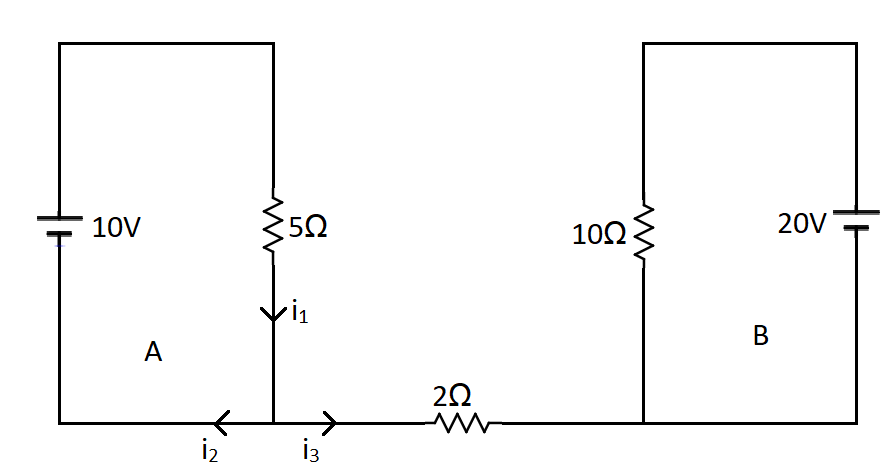
Find out the value of current through $2\Omega $ resistance for the given circuit.

(A) Zero
(B) $2A$
(C) $4A$
(D) $5A$

Answer
553.8k+ views
Hint
For any closed circuit, the current that is coming out of a cell is equal to the current that is entering the cell through the negative terminal. Since the $2\Omega $ resistance is not a part of any closed circuit, so the current through it is zero.
Complete step by step answer
In the diagram we can see that there are 2 loops. Let us name them A and B as in the figure.

On the first loop that is A, let us consider that the current coming out of the cell of $10V$is ${i_1}$. At the junction, let the current be divided into two parts namely as ${i_2}$ and ${i_3}$. Now for the cell $10V$ in the circuit, the amount of current that is coming out of the positive terminal should be equal to the current that is entering the negative terminal of the battery in turn. So the current ${i_2}$ should have a value equal to ${i_1}$. Now we can write that,
${i_1} = {i_2} + {i_3}$
Now since, ${i_1}$ is equal to ${i_2}$ so we can write,
${i_1} = {i_1} + {i_3}$
Therefore we get, the current ${i_3}$ is equal to zero due to the cell $10V$.
Similarly, in the case of the closed loop B, the amount of current that is coming out of the positive terminal will be equal to the current that is entering the negative terminal.
So the current in the $2\Omega $ resistor due to the cell $20V$ will also be zero. Now since the $2\Omega $ resistor is not a part of any loop, so the current in that resistor due to both the cells will be zero.
Hence the value of current in the $2\Omega $ resistor in the given circuit is zero.
So the correct answer will be option A.
Note
In the solution we have used the condition ${i_1} = {i_2} + {i_3}$ for the first loop A. This is because of Kirchhoff's current law. It states that the total current that is entering a circuit junction is equal to the total current that is leaving the same junction.
For any closed circuit, the current that is coming out of a cell is equal to the current that is entering the cell through the negative terminal. Since the $2\Omega $ resistance is not a part of any closed circuit, so the current through it is zero.
Complete step by step answer
In the diagram we can see that there are 2 loops. Let us name them A and B as in the figure.

On the first loop that is A, let us consider that the current coming out of the cell of $10V$is ${i_1}$. At the junction, let the current be divided into two parts namely as ${i_2}$ and ${i_3}$. Now for the cell $10V$ in the circuit, the amount of current that is coming out of the positive terminal should be equal to the current that is entering the negative terminal of the battery in turn. So the current ${i_2}$ should have a value equal to ${i_1}$. Now we can write that,
${i_1} = {i_2} + {i_3}$
Now since, ${i_1}$ is equal to ${i_2}$ so we can write,
${i_1} = {i_1} + {i_3}$
Therefore we get, the current ${i_3}$ is equal to zero due to the cell $10V$.
Similarly, in the case of the closed loop B, the amount of current that is coming out of the positive terminal will be equal to the current that is entering the negative terminal.
So the current in the $2\Omega $ resistor due to the cell $20V$ will also be zero. Now since the $2\Omega $ resistor is not a part of any loop, so the current in that resistor due to both the cells will be zero.
Hence the value of current in the $2\Omega $ resistor in the given circuit is zero.
So the correct answer will be option A.
Note
In the solution we have used the condition ${i_1} = {i_2} + {i_3}$ for the first loop A. This is because of Kirchhoff's current law. It states that the total current that is entering a circuit junction is equal to the total current that is leaving the same junction.
Recently Updated Pages
Master Class 12 Economics: Engaging Questions & Answers for Success

Master Class 12 Maths: Engaging Questions & Answers for Success

Master Class 12 Biology: Engaging Questions & Answers for Success

Master Class 12 Physics: Engaging Questions & Answers for Success

Basicity of sulphurous acid and sulphuric acid are

Master Class 12 Business Studies: Engaging Questions & Answers for Success

Trending doubts
What are the major means of transport Explain each class 12 social science CBSE

Which are the Top 10 Largest Countries of the World?

Draw a labelled sketch of the human eye class 12 physics CBSE

How much time does it take to bleed after eating p class 12 biology CBSE

Explain sex determination in humans with line diag class 12 biology CBSE

Differentiate between homogeneous and heterogeneous class 12 chemistry CBSE




